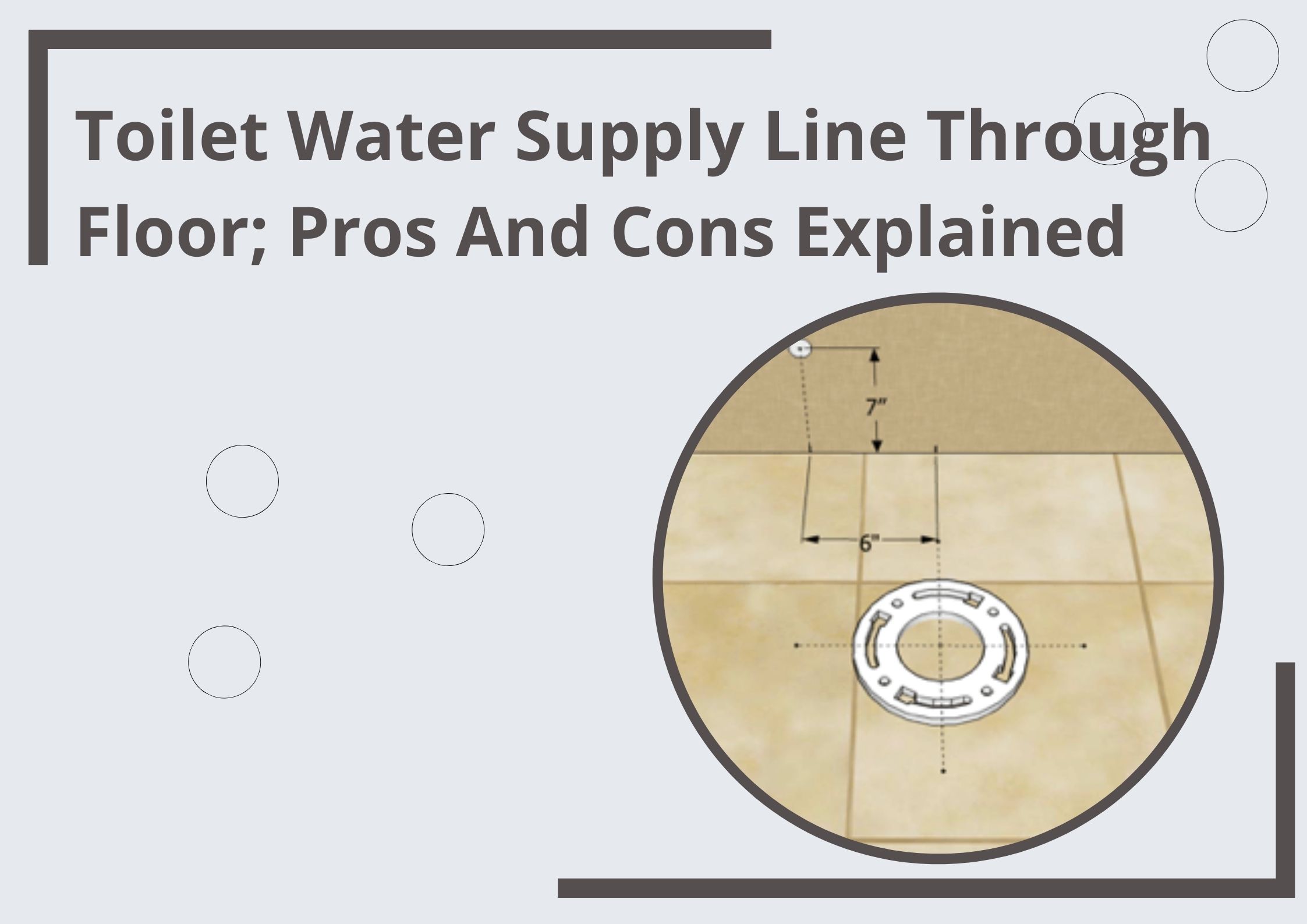Toilet Water Supply Line Through Floor; Pros And Cons Explained
Quick Read; When installing a toilet water supply line through the floor, ensure tight, sealed connections with Teflon tape or pipe dope. Check for leaks during assembly and proper floor condition. Use flexible, high-quality supply lines, secure the floor flange, and consider blocking or clamps for support. Test for leaks after installation and maintain regularly.
In this article, we’ll explore the advantages and drawbacks of setting a toilet water supply line through the floor. Discover the benefits of space-saving aesthetics and potential challenges in this comprehensive overview of a common plumbing choice.
Table of Contents
Can you set the toilet water supply line through the floor?

Yes, you can set a toilet water supply line through the floor. This involves installing a floor flange, angle stop valve, and connecting a water supply line to the toilet.
- First, turn off the water supply, remove the old toilet, and secure the floor flange.
- Then, attach the angle stop valve to it and connect the water supply line to the toilet tank. Finally, turn on the water supply and check for leaks.
It’s a manageable DIY task with the right tools and materials, but if unsure, consulting a plumber is a wise option to ensure a proper installation.
What are the pros and cons of setting the toilet water supply line through the floor?
Setting the toilet water supply line through the floor has its own set of pros and cons:
Pros
- Space-Saving: Installing the water supply line through the floor can save space compared to having it come out of the wall. This can be especially beneficial in small bathrooms where every inch of space counts.
- Aesthetically Pleasing: Some people prefer the cleaner look of a toilet with the water supply line concealed beneath the floor, as it eliminates visible pipes and fittings on the wall.
- Less Vulnerable: Water supply lines through the floor are less susceptible to accidental damage or being bumped compared to those on the wall.
How Hard Is The Journeyman Plumber Test? All You Need To Know
plumbinsight.com
Cons
- Complex Installation: Installing a toilet water supply line through the floor can be more complex and time-consuming than a wall-mounted, possibly dealing with structural or subflooring issues.
- Potential for Leaks: Concealed water supply lines can be harder to access for maintenance or in case of leaks, which might result in increased repair costs and inconvenience.
- Limited Flexibility: Once installed through the floor, it can be challenging to change the toilet’s position or layout in the bathroom, which may be a disadvantage if you plan to remodel or rearrange the bathroom in the future.
- Costs: The installation process might be more expensive if you need to hire a plumber or if you encounter unexpected issues with your plumbing system or subfloor during installation.
In summary, the decision to set the toilet water supply line through the floor depends on your preferences, space constraints, and willingness to handle the potential challenges associated with this approach. It’s essential to weigh the pros and cons and consider your specific circumstances before choosing.
Where do you put the toilet supply line through the floor?
When setting a toilet supply line through the floor, the location where you put it typically depends on your bathroom’s layout and your specific preferences. Here’s a general guideline on where to position the toilet supply line through the floor:
01. Centered Behind the Toilet
One common placement is to have the supply line come up through the floor directly behind the toilet. This location often allows for a straightforward and neat installation. Measuring and marking the exact spot is essential to ensure it aligns with the toilet’s inlet.
02. Offset from the Center
Depending on your bathroom’s design or the toilet’s rough-in distance (the distance from the wall to the center of the drain pipe), you might need to offset the supply line slightly to the left or right of the toilet’s centerline.
03. In-line with the Toilet Drain Pipe
You might sometimes choose to align the supply line with the toilet’s drain pipe. This can create a clean and symmetrical look, especially when dealing with multiple fixtures in a bathroom.
04. Under the Toilet
You can run the supply line underneath the toilet and have it emerge near the toilet’s base for a more concealed look. This approach can be aesthetically pleasing but may require more extensive installation work.
It’s crucial to measure and plan the placement carefully before cutting any holes in the floor. Ensure that the water supply line aligns correctly with the toilet’s inlet and that it’s positioned securely to avoid leaks or damage. If you’re unsure about the best location for your specific bathroom setup, consulting with a professional plumber can be beneficial.
Hose Clamp Alternatives; Best Alternatives Explained
plumbinsight.com
How do you make sure there are no leaks and blocking?
To ensure no leaks and proper blocking when setting a toilet water supply line through the floor, follow these steps and precautions:
- Properly Seal All Connections:
- Use high-quality materials such as brass or stainless steel for fittings and connectors.
- To create a watertight seal, apply Teflon tape or pipe dope to all threaded connections.
- Tighten all connections snugly but avoid over-tightening, which can damage threads.
- Check for Leaks During Installation:
- Regularly check for leaks as you assemble the supply line by temporarily turning on the water supply. Address any leaks immediately by tightening connections or reapplying sealant.
- Use Compression or SharkBite Fittings:
- Compression or SharkBite-style push-to-connect fittings can simplify installation and provide a reliable seal without the need for soldering (for copper pipes).
- Inspect the Floor and Subfloor:
- Ensure the floor and subfloor are in good condition and free of rot or damage. Repair any issues before installation.
- Properly Secure the Floor Flange:
- Secure the floor flange tightly to the subfloor to prevent movement or wobbling of the toilet. Use screws or bolts designed for this purpose.
- Use the Right Type of Supply Line:
- Select a flexible supply line made of braided stainless steel or PEX, which are less prone to leaks than older, rigid types.
- Install Blocking or Support:
- To prevent the supply line from rubbing against sharp edges or corners, consider using plastic or metal clamps to secure it to the floor or nearby structure.
- Test for Leaks Thoroughly:
- After the installation and the toilet are in place, turn on the water supply and check for leaks. Be patient and thorough during this testing phase.
- Regular Maintenance:
- Periodically inspect the supply line and its connections for wear or leaks. Replace any damaged components promptly.
- Seek Professional Assistance:
- If you’re uncertain about any aspect of the installation or if you encounter persistent leaks, it’s advisable to consult a licensed plumber for guidance and assistance.
By following these steps and being diligent during installation and testing, you can help ensure a reliable and leak-free toilet water supply line through the floor.
How Do you Identify A Faulty Toilet Water Supply Line?

Identifying a faulty toilet water supply line is essential to prevent leaks and water damage. Common signs of an issue include visible water drips or puddles near the toilet base or supply valve. A constantly running toilet or inconsistent flushing may also indicate a problem.
Inspect the supply line for visible cracks, corrosion, or bulges, and check for dampness or discoloration in the surrounding area. If you suspect a fault, turn off the water supply, and if necessary, consult a plumber to address the issue promptly and prevent potential water damage. Regular maintenance and inspection can help catch problems early and avoid costly repairs.
Rough Plumbing For Rear Discharge Toilet; Complete Guide
plumbinsight.com
Some related FAQs
What do you put between toilet and floor?
You place a wax ring or wax gasket between the toilet and the floor. This creates a watertight seal, preventing leaks and odors. Ensure proper alignment and seating of the toilet on the wax ring before securing it to the floor with bolts.
How do you secure a toilet supply line?
To secure a toilet supply line, connect it to the toilet tank’s fill valve and tighten the nut by hand. Use a wrench or pliers to give it a final snug turn, but avoid over-tightening to prevent damage. Ensure no kinks or twists are in the supply line, allowing water to flow freely.
Should toilet pipe be flush with floor?
Yes, the toilet waste pipe (also known as the closet flange or toilet flange) should be flush with the finished floor surface. This ensures a proper and stable connection between the toilet and the sewer or septic system. If the flange is not flush with the floor, it can lead to leaks, rocking toilets, and other installation issues. You may need to use flange extenders or adjustments to bring the flange to the correct height. Proper alignment is essential for a secure and leak-free toilet installation.



